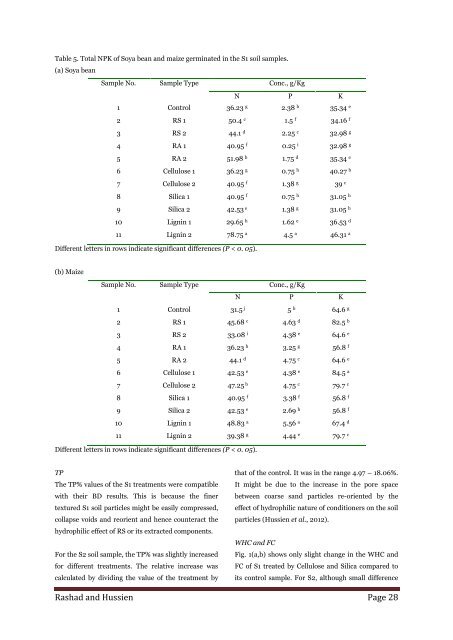Studying the use of cellulose, silica and lignin extracted from rice straw as sandy soil conditioners
Rice straw is a renewable natural resource was recycled as an agricultural waste containing some natural biopolymers. The study aims to evaluate the rice straw (RS) as well as straw ash (RA), Cellulose, Silica and Lignin extracted from the straw as environment friendly agricultural sandy soil conditioners. Some properties of these polymers are expected to affect some properties of soil as well as the macro-nutrient uptake by plant. The mentioned materials were extracted from RS then mixed with two soil samples different in their properties selected for the study and some of their properties were estimated. Soya bean and maize were germinated in different soil/conditioner mixtures and their nutritional content, NPK total content was estimated and the data were statistically analyzed. For the non-calcareous soil sample, the BD showed a relative decrease in the range 3.46% – 12.64% while the TP increased in the range 4.97 – 18.06% and the relative decrease in HC was in the range 5.63 and 91.82%. The accumulation of soluble salts, available and total NPK concentrations had been affected. The chemical structure of the studied biopolymers possessing functional groups (‒NH, ‒OH, ‒COOH) and partial solubility of silica may offer chemical bonding and/or some other interaction with the different nutritional ions and adsorption sites affecting their solubility and availability within soil. The remediation effect is strongly dependent on the soil texture and salinity levels denoting to the chemical equilibria of the soil solution, accumulation of the soluble salts, nutrients in soil and the nutrient uptake by plants.
Rice straw is a renewable natural resource was recycled as an agricultural waste containing some natural biopolymers. The study aims to evaluate the rice straw (RS) as well as straw ash (RA), Cellulose, Silica and Lignin extracted from the straw as environment friendly agricultural sandy soil conditioners. Some properties of these polymers are expected to affect some properties of soil as well as the macro-nutrient uptake by plant. The mentioned materials were extracted from RS then mixed with two soil samples different in their properties selected for the study and some of their properties were estimated. Soya bean and maize were germinated in different soil/conditioner mixtures and their nutritional content, NPK total content was estimated and the data were statistically analyzed. For the non-calcareous soil sample, the BD showed a relative decrease in the range 3.46% – 12.64% while the TP increased in the range 4.97 – 18.06% and the relative decrease in HC was in the range 5.63 and 91.82%. The accumulation of soluble salts, available and total NPK concentrations had been affected. The chemical structure of the studied biopolymers possessing functional groups (‒NH, ‒OH, ‒COOH)
and partial solubility of silica may offer chemical bonding and/or some other interaction with the different nutritional ions and adsorption sites affecting their solubility and availability within soil. The remediation effect is strongly dependent on the soil texture and salinity levels denoting to the chemical equilibria of the soil solution, accumulation of the soluble salts, nutrients in soil and the nutrient uptake by plants.
Create successful ePaper yourself
Turn your PDF publications into a flip-book with our unique Google optimized e-Paper software.
Table 5. Total NPK <strong>of</strong> Soya bean <strong>and</strong> maize germinated in <strong>the</strong> S1 <strong>soil</strong> samples.<br />
(a) Soya bean<br />
Sample No. Sample Type Conc., g/Kg<br />
N P K<br />
1 Control 36.23 g 2.38 b 35.34 e<br />
2 RS 1 50.4 c 1.5 f 34.16 f<br />
3 RS 2 44.1 d 2.25 c 32.98 g<br />
4 RA 1 40.95 f 0.25 i 32.98 g<br />
5 RA 2 51.98 b 1.75 d 35.34 e<br />
6 Cellulose 1 36.23 g 0.75 h 40.27 b<br />
7 Cellulose 2 40.95 f 1.38 g 39 c<br />
8 Silica 1 40.95 f 0.75 h 31.05 h<br />
9 Silica 2 42.53 e 1.38 g 31.05 h<br />
10 Lignin 1 29.65 h 1.62 e 36.53 d<br />
11 Lignin 2 78.75 a 4.5 a 46.31 a<br />
Different letters in rows indicate significant differences (P < 0. 05).<br />
(b) Maize<br />
Sample No. Sample Type Conc., g/Kg<br />
N P K<br />
1 Control 31.5 j 5 b 64.6 g<br />
2 RS 1 45.68 c 4.63 d 82.5 b<br />
3 RS 2 33.08 i 4.38 e 64.6 e<br />
4 RA 1 36.23 h 3.25 g 56.8 f<br />
5 RA 2 44.1 d 4.75 c 64.6 e<br />
6 Cellulose 1 42.53 e 4.38 e 84.5 a<br />
7 Cellulose 2 47.25 b 4.75 c 79.7 c<br />
8 Silica 1 40.95 f 3.38 f 56.8 f<br />
9 Silica 2 42.53 e 2.69 h 56.8 f<br />
10 Lignin 1 48.83 a 5.56 a 67.4 d<br />
11 Lignin 2 39.38 g 4.44 e 79.7 c<br />
Different letters in rows indicate significant differences (P < 0. 05).<br />
TP<br />
The TP% values <strong>of</strong> <strong>the</strong> S1 treatments were compatible<br />
with <strong>the</strong>ir BD results. This is beca<strong>use</strong> <strong>the</strong> finer<br />
textured S1 <strong>soil</strong> particles might be e<strong>as</strong>ily compressed,<br />
collapse voids <strong>and</strong> reorient <strong>and</strong> hence counteract <strong>the</strong><br />
hydrophilic effect <strong>of</strong> RS or its <strong>extracted</strong> components.<br />
For <strong>the</strong> S2 <strong>soil</strong> sample, <strong>the</strong> TP% w<strong>as</strong> slightly incre<strong>as</strong>ed<br />
for different treatments. The relative incre<strong>as</strong>e w<strong>as</strong><br />
calculated by dividing <strong>the</strong> value <strong>of</strong> <strong>the</strong> treatment by<br />
that <strong>of</strong> <strong>the</strong> control. It w<strong>as</strong> in <strong>the</strong> range 4.97 – 18.06%.<br />
It might be due to <strong>the</strong> incre<strong>as</strong>e in <strong>the</strong> pore space<br />
between coarse s<strong>and</strong> particles re-oriented by <strong>the</strong><br />
effect <strong>of</strong> hydrophilic nature <strong>of</strong> <strong>conditioners</strong> on <strong>the</strong> <strong>soil</strong><br />
particles (Hussien et al., 2012).<br />
WHC <strong>and</strong> FC<br />
Fig. 1(a,b) shows only slight change in <strong>the</strong> WHC <strong>and</strong><br />
FC <strong>of</strong> S1 treated by Cellulose <strong>and</strong> Silica compared to<br />
its control sample. For S2, although small difference<br />
R<strong>as</strong>had <strong>and</strong> Hussien Page 28


















